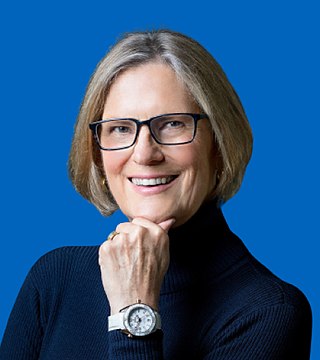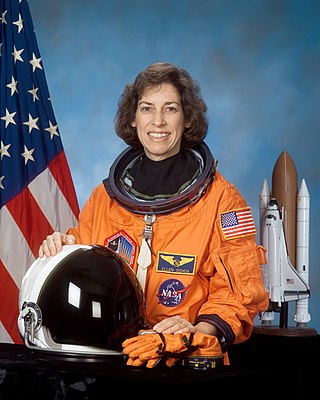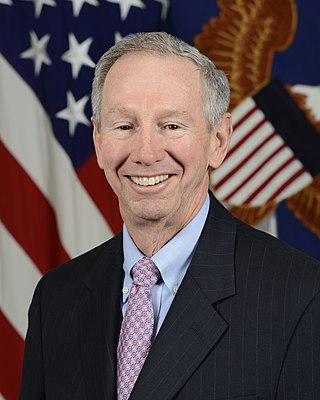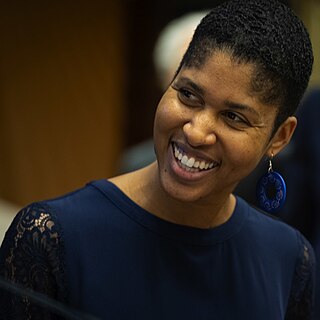
A space suit or spacesuit is a garment worn to keep a human alive in the harsh environment of outer space, vacuum and temperature extremes. Space suits are often worn inside spacecraft as a safety precaution in case of loss of cabin pressure, and are necessary for extravehicular activity (EVA), work done outside spacecraft. Space suits have been worn for such work in Earth orbit, on the surface of the Moon, and en route back to Earth from the Moon. Modern space suits augment the basic pressure garment with a complex system of equipment and environmental systems designed to keep the wearer comfortable, and to minimize the effort required to bend the limbs, resisting a soft pressure garment's natural tendency to stiffen against the vacuum. A self-contained oxygen supply and environmental control system is frequently employed to allow complete freedom of movement, independent of the spacecraft.

Kathryn Dwyer Sullivan is an American geologist, oceanographer, and former NASA astronaut and US Navy officer. She was a crew member on three Space Shuttle missions.

Charles Frank Bolden Jr. is a former Administrator of NASA, a retired United States Marine Corps Major General, and a former astronaut who flew on four Space Shuttle missions.

Bonnie Jeanne Dunbar is an American engineer and retired NASA astronaut. She flew on five Space Shuttle missions between 1985 and 1998, including two dockings with the Mir space station.

Anthony Wayne "Tony" England is an American former NASA astronaut. Selected in 1967, England was among a group of astronauts who served as backups during the Apollo and Skylab programs. Like most others in his class, he flew during the Space Shuttle program, serving as a mission specialist on STS-51-F in 1985. He has logged more than 4,000 hours of flying time and 188 hours in space.

The Manned Orbiting Laboratory (MOL) was part of the United States Air Force (USAF) human spaceflight program in the 1960s. The project was developed from early USAF concepts of crewed space stations as reconnaissance satellites, and was a successor to the canceled Boeing X-20 Dyna-Soar military reconnaissance space plane. Plans for the MOL evolved into a single-use laboratory, for which crews would be launched on 30-day missions, and return to Earth using a Gemini B spacecraft derived from NASA's Gemini spacecraft and launched with the laboratory.

Ellen Ochoa is an American engineer, former astronaut and former director of the Johnson Space Center. In 1993, Ochoa became the first Latina woman to go to space when she served on a nine-day mission aboard the Space Shuttle Discovery. Ochoa became director of the center upon the retirement of the previous director, Michael Coats, on December 31, 2012. She was the first Latina director and the second female director of Johnson Space Center.

Ronald Michael "Ron" Sega is an American former astronaut who is professor of systems engineering and Vice President for Energy and the Environment at the Colorado State University Research Foundation, a non-profit advocacy organization supporting CSU. He is also the Vice President and Enterprise Executive for Energy and Environment at Ohio State University. From August 2005 to August 2007, he served as Under Secretary of the Air Force. He is a retired major general in the United States Air Force and a former NASA astronaut. Sega was born in Cleveland, Ohio, he is of Slovene origin. He was married to fellow astronaut Bonnie J. Dunbar. He is now married to Ann Sega and they have two sons. He has lived in both Northfield, Ohio and Colorado Springs.

A mechanical counterpressure (MCP) suit, partial pressure suit, direct compression suit, or space activity suit (SAS) is an experimental spacesuit which applies stable pressure against the skin by means of skintight elastic garments. The SAS is not inflated like a conventional spacesuit: it uses mechanical pressure, rather than air pressure, to compress the human body in low-pressure environments. Development was begun by NASA and the Air Force in the late 1950s and then again in the late 1960s, but neither design was used. Research is under way at the Massachusetts Institute of Technology (MIT) on a "Bio-Suit" System which is based on the original SAS concept.

The Extravehicular Mobility Unit (EMU) is an independent anthropomorphic spacesuit that provides environmental protection, mobility, life support, and communications for astronauts performing extravehicular activity (EVA) in Earth orbit. Introduced in 1981, it is a two-piece semi-rigid suit, and is currently one of two types of EVA spacesuits used by crew members on the International Space Station (ISS), the other being the Russian Orlan space suit. It was used by NASA's Space Shuttle astronauts prior to the end of the Shuttle program in 2011.

Michael Douglas Griffin is an American physicist and aerospace engineer who served as the Under Secretary of Defense for Research and Engineering from 2018 to 2020. He previously served as Deputy of Technology for the Strategic Defense Initiative, and as Administrator of NASA from April 13, 2005, to January 20, 2009. As NASA Administrator Griffin oversaw such areas as private spaceflight, future human spaceflight to Mars, and the fate of the Hubble telescope.

The Coalition for Deep Space Exploration is a United States space advocacy organization for space industry businesses and non-profit groups supporting continued government investment in space exploration.

Hans Michael Mark was a German-born American government official who served as Secretary of the Air Force and as a Deputy Administrator of NASA. He was an expert and consultant in aerospace design and national defense policy.

The Space Systems Laboratory (SSL) is part of the Aerospace Engineering Department and A. James Clark School of Engineering at the University of Maryland in College Park, Maryland. The Space Systems Laboratory is centered on the Neutral Buoyancy Research Facility, a 50-foot-diameter (15 m), 25-foot-deep (7.6 m) neutral buoyancy pool used to simulate the microgravity environment of space. The only such facility housed at a university, Maryland's neutral buoyancy tank is used for undergraduate and graduate research at the Space Systems Lab. Research in Space Systems emphasizes space robotics, human factors, applications of artificial intelligence and the underlying fundamentals of space simulation. There are currently five robots being tested, including Ranger, a four-armed satellite servicing robot, and SCAMP, a six-degree of freedom free-flying underwater camera platform. Ranger was funded by NASA starting in 1992, and was to be a technological demonstration of orbital satellite servicing. NASA was never able to manifest it for launch and the program was defunded circa 2006. For example, Ranger development work at the SSL continues, albeit at a slower pace; Ranger was used to demonstrate robotic servicing techniques for NASA's proposed robotic Hubble Servicing Mission.
In the field of biomechanics, the lines of non-extension are notional lines running across the human body along which body movement causes neither stretching or contraction. Discovered by Arthur Iberall in work beginning in the 1940s, as part of research into space suit design, they have been further developed by Dava Newman in the development of the Space Activity Suit.

Locomotion in space includes all actions or methods used to move one's body in microgravity conditions through the outer space environment. Locomotion in these conditions is different from locomotion in a gravitational field. There are many factors that contribute to these differences, and they are crucial when researching long-term survival of humans in space.

A Mars suit or Mars space suit is a space suit for EVAs on the planet Mars. Compared to a suit designed for space-walking in the near vacuum of low Earth orbit, Mars suits have a greater focus on actual walking and a need for abrasion resistance. Mars' surface gravity is 37.8% of Earth's, approximately 2.3 times that of the Moon, so weight is a significant concern, but there are fewer thermal demands compared to open space. At the surface the suits would contend with the atmosphere of Mars, which has a pressure of about 0.6 to 1 kilopascal. On the surface, radiation exposure is a concern, especially solar flare events, which can dramatically increase the amount of radiation over a short time.

Danielle Wood is an assistant professor in the MIT Media Lab, where she directs the research group Space Enabled. Prior to joining MIT, Wood worked as special assistant to Dava Newman at NASA. Wood looks to advance justice using technology created in space.
Kavya K. Manyapu is an Indian–American aerospace engineer and scientist. She currently works at NASA in the Extravehicular Branch for Lunar Exploration missions within the Flight Operations Directorate at JSC. She was part of the Boeing team that developed the CST-100 Starliner spacecraft for nearly 10 years. She developed a novel technology for self-cleaning space suits that uses carbon nanotubes to repel dust for use in future lunar and Mars missions.

















